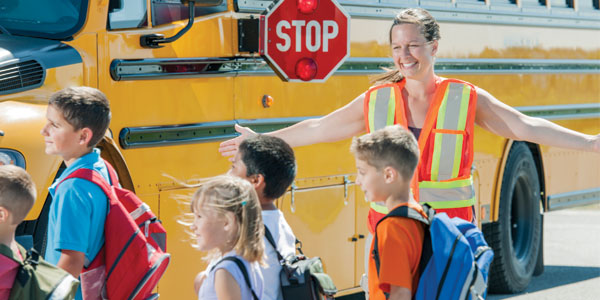
Another school year means millions of children across the country are boarding buses at the beginning and end of each day, and it provides an appropriate opportunity for parents, teachers, school administrators and students themselves to practice and enforce safety guidelines in and around the school bus.
Consider these tips from the experts at the Propane Education & Research Council (PERC) to help keep children safe before bus rides, during travel and after exiting the vehicle.
Before the Bus Arrives
*Ensure backpacks are packed securely so papers and other items don’t scatter as the bus approaches.
*Create a morning routine that puts kids at the bus stop five minutes before the scheduled pickup time. This helps avoid a last-minute rush, when safety lessons are easily forgotten, and ensures kids are safely in place for boarding.
*Encourage children to wear bright, contrasting colors so they can be seen easier by drivers.
*Instruct children to walk on the sidewalk. If there is no sidewalk, advise them to stay out of the street, walk single-file, face traffic and stay as close to the edge of the road as possible.
*Walk young children to the bus stop or encourage kids to walk in groups. There is safety in numbers; groups are easier for drivers to see.
*If kids must cross a street, driveway or alley, remind them to stop and look both ways before crossing.
*Verify the bus stop location offers good visibility for the bus driver; if changes are needed, talk with nearby homeowners or school district officials to implement changes. Never let kids wait in a house or car, where the driver may miss seeing them approach the bus.
*Remind children that the bus stop is not a playground. Balls or other toys could roll into the street and horseplay can result in someone falling into the path of oncoming traffic.
*Instruct children to stay at least three steps away from the road and allow the bus to come to a complete stop before approaching it.
On the Bus Ride
*When boarding the bus, items can get bumped and dropped. Caution children that before picking anything up, they should talk to the driver and follow instructions to safely retrieve their possessions.
*Teach safe riding habits: stay seated with head, hands and feet inside at all times; keep bags and books out of the aisle and remain seated until the bus stops moving.
*Remind kids that just like when riding in cars, loud noises are off limits so they don’t distract the driver. That includes cellphones and other electronic devices; instruct children to put them on mute or use headphones.
Leaving the Bus
*Remind children to look before stepping off the bus. If they must cross the street, teach them to do so in front of the bus by taking five big steps (approximately 10 feet) away from the front of the bus, looking up and waiting for the driver to signal that it is safe.
*For parents who meet their kids at the bus, remember that excited kids may dart across the street. Eliminate the risk by waiting on the side of the street where kids exit the bus.
*Make the bus ride part of your daily “how was school?” discussion. Encourage kids to talk about the things they see and hear on the bus so you can discuss appropriate behaviors and, if necessary, report any concerns to school administrators.
*As bullying is prevalent and buses are no exception, ask children to tell you about any bullying they observe, whether against another child or themselves, and talk about how to shut down bully behaviors.
Visit BetterOurBuses.com for more school bus safety tips and information.
Seguridad del autobús para el regreso a clases
Otro año escolar significa que millones de niños en todo el país están subiendo autobuses al principio y al final de cada día, y brinda un oportunidad adecuada para que los padres, maestros, administradores escolares y los propios estudiantes practiquen y apliquen pautas de seguridad dentro y alrededor del autobús escolar.
Considere estos consejos de los expertos Consejo de Educación e Investigación de Propano (PERC, por sus siglas en inglés) para ayudar a mantener seguros a los niños antes de viajar en autobús, durante el viaje y después de salir del vehículo.
Antes de que llegue el autobús
*Asegúrese de que las mochilas estén aseguradas para que papeles y otros artículos no se dispersen cuando se acerque el autobús.
*Cree una rutina matutina que ponga a los niños en la parada del autobús cinco minutos antes de la hora programada de recogida. Esto ayuda a evitar un apuro de último minuto, cuando las lecciones de seguridad se olvidan fácilmente, y garantiza que los niños estén seguros para embarcar.
*Anime a los niños a usar colores brillantes y contrastantes para que los conductores puedan verlos más fácilmente.
*Instruya a los niños a caminar por la acera. Si no hay una acera, aconseje que se mantengan alejados de la calle, que caminen en una sola fila, mirando el tráfico y que se mantengan lo más cerca posible del borde de la carretera.
*Lleve a los niños pequeños a la parada del autobús o aliéntelos a caminar en grupos. Hay seguridad en los números; los grupos son más fáciles de ver para los conductores.
*Si los niños deben cruzar una calle, entrada o callejón, recuérdeles que se detengan y miren a ambos lados antes de cruzar.
*Verifique que la ubicación de la parada de autobús ofrezca una buena visibilidad para el conductor del autobús; si se necesitan cambios, hable con propietarios de viviendas cercanos o con funcionarios del distrito escolar para implementar los cambios. Nunca permita que los niños esperen en una casa o automóvil, donde el conductor puede perder verlos acercarse al autobús.
*Recuerde a los niños que la parada del autobús no es un patio de recreo. Las pelotas u otros juguetes podrían rodar hacia la calle y los juegos bruscos pueden provocar que alguien caiga en el camino del tráfico que se aproxima.
*Indique a los niños que permanezcan al menos a tres pasos de distancia de la calle y permitir que el autobús se detenga por completo antes de acercarse a él.
Durante el viaje en autobús
*Al subir al autobús, los artículos pueden moverse y caerse. Advierta a los niños que antes de recoger cualquier cosa, deben hablar con el conductor y seguir las instrucciones para recuperar sus pertenencias de manera segura.
*Enseñe hábitos de viaje seguros: permanezca sentado con la cabeza, las manos y los pies adentro en todo momento; mantenga las bolsas y los libros fuera del pasillo y permanezca sentado hasta que el autobús deje de moverse.
*Recuerde a los niños que, al igual que cuando viajan en automóviles, los ruidos fuertes están prohibidos para que no distraigan al conductor. Eso incluye teléfonos celulares y otros dispositivos electrónicos; Indique a los niños que los pongan en silencio o que usen auriculares.
Saliendo del autobús
*Recuerde a los niños que miren antes de bajarse de autobús. Si deben cruzar la calle, enséñeles a hacerlo enfrente del autobús dando cinco pasos grandes (aproximadamente 10 pies) de distancia desde la parte delantera del autobús, mirando hacia arriba y esperando que el conductor señale que es seguro.
*Para los padres que se encuentran con sus hijos en el autobús, recuerden que los niños entusiasmados pueden cruzar la calle. Elimine el riesgo esperando en el lado de la calle donde los niños salen del autobús.
*Haga que el viaje en autobús sea parte de su discusión diaria de “¿cómo estuvo la escuela?”. Aliente a los niños a hablar sobre las cosas que ven y escuchan en el autobús para que puedan hablar sobre los comportamientos apropiados y, si es necesario, informar cualquier inquietud a los administradores escolares.
*Como el bullying es frecuente y los autobuses no son la excepción, pídales a los niños que le informen sobre cualquier incidente de bullying que observen, ya sea contra otro niño o contra ellos mismos, y hable sobre cómo detener los comportamientos de bullying.
Visite BetterOurBuses.com para obtener más consejos e información sobre la seguridad del autobús escolar.










